
Original Link: https://www.anandtech.com/show/2487
Enermax Launches the Pro82+ and Modu82+
by Christoph Katzer on March 25, 2008 1:00 AM EST- Posted in
- Cases/Cooling/PSUs
Introduction
We saw the first prototypes of the Pro82+ and Modu82+ series at CES, and we eagerly awaited our samples since then. At the following CeBIT in March, Enermax showed these two new series again but still we waited for our samples. After returning from CeBIT, we finally found our batch of PSUs at our doorstep and we started testing right away.
It wasn't too long ago that Enermax introduced the Infiniti series, which performed well in our testing, so we were quite excited to see how Enermax would top that performance. We heard from Enermax that these two new series would have performance equal to the Infiniti but at a cheaper price point. We initially thought these new power supplies used the basic Infiniti design, but we were told that this is not the case.

Enermax wouldn't be Enermax if they didn't include some new technologies in a new series. We will examine today what improvements Enermax made and how they function. We look at both new series today; they are essentially the same internally but play a different role on the outside. As the name suggests, the Modu series comes with modular cables. The Pro series doesn't have modular cables, which is the only difference between it and the Modu series.
Enermax was one of first companies to begin selling retail power supply several years ago. They are one of the oldest companies in this field, with several inventions to their credit during this time. According to the company, Enermax was the first to offer a colored power supply, and they were the first to provide an external fan speed controller. We don't know for sure if that's really true, and we can't say that colored PSUs is really that revolutionary, but Enermax does seem to be at the forefront of new PSU innovations, and they rank in the top five in terms of sales.
Their trend of staying ahead in the market place continues, with some very competitive power supplies in their two new series.
Enermax Modu82+

The new Modu82+ series is all about cable management. Included is a very intelligent system that allows the user to be ready for any changes in the future, according to Enermax. We will find out later if this is the case. The package promises up to 88% efficiency, which is a very high goal to reach. We will also pay attention to the fan controller, as it's another new invention according to the manufacturer. Enermax also angled the metal plate at the fan to lower the acoustic noise when the air comes through.


We received the 525W and 625W models for testing. There is also a 425W version of the Modu82+ series. Both of our samples have very similar specifications. All the rails have the same rating; the only difference is the combined power of the three 12V rails. All three specify 25A on both versions, but the combined power of the 525W is 480W (40A) while on the 625W it's 600W (50A). This can only be done with different limiters on these rails. The 12V rails are the most important, but the smaller voltage rails are all rated at 24A, which is enough for today's systems.
Modu82+ Package and Appearance

The power supply comes in a very nice color box with all the necessary information on it. The unit is encased in bubble wrap to protect it from shipping damages. Enermax typically includes a variety of accessories in their packages. In this case, besides the normal stuff like screws, a power cord, and the manual, we also get a nice cable tie, a bag for unused cables, and stickers.

The power supply comes is a gunmetal color and has a golden fan grille. The latest trend is for manufacturers to print a large logo on the side of their PSUs, or at least attach a large sticker. The Modu82+ series follows this pattern, with its name printed on the side panel. Users can't normally see this logo after installing the PSU in a case, and now it's not possible to see the label with the PSU specifications without removing the PSU, but nobody seems to care. The specifications label is now on top of the power supply, because users don't read it anyway after the unit is installed in a system. The back of the casing is totally perforated to serve as an exhaust.

The front provides the jacks for the cable management system. There are two large 12-pin red jacks and five 5-pin black jacks. The smaller black jacks are reserved for peripheral components like hard drives and optical drives. The red ones are for the graphics card connectors. Enermax states that the 12-pin jacks are "future ready", as they can release updated cables should the need arise.

You can see in the above image that Enermax trimmed the edges of the opening around the bottom fan. Enermax says this additional angle allows the air to enter the power supply more smoothly and thereby reduce noise levels. Since the fan is already quiet and runs at a very slow speed, we couldn't really notice a difference in acoustic noise.
Modu82+ Cables and Connectors

As already stated, Enermax has two red jacks for the PEG connectors and five for peripheral connectors. The 425W version (which is not included in today's test) only has four peripheral jacks. The 525W and 625W models have different harnesses in the package. The bigger brother comes with five harnesses, and two of these include have two Molex and a floppy connector. The other three harnesses each have three SATA connectors, providing up to nine SATA power connectors. All the harnesses are sleeved with Enermax's standard black mesh with a golden thread. There is one 4-pin and one 8-pin ATX 12V connector available, which is a nice addition instead of an 8-pin connector that can be split in half to get a normal 4-pin connector.



Enermax designed new connectors for easy unplugging. To unplug the connectors you only need to depress the hooks on the two sides. Then you can easily pull the connector out of the jack. The 12-pin connectors are one of the latest additions from Enermax, and they waste no time in advertising it. The idea is that the 12-pin jack with six 12V pins and six ground pins can be modified for future needs. All the company has to do is design a new plug that uses these pins in a different way. If a new connector for CPUs and/or GPUs comes out, Enermax can easily use the old jack on the power supply and sell users a new harness with the correct connectors on it.
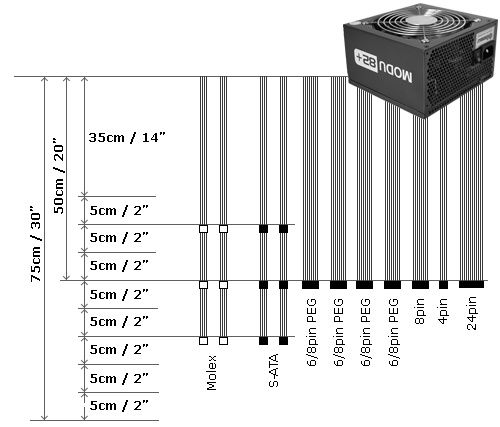
The included harnesses are rather short with the Modu82+ series. Otherwise, it has everything a midrange to high-end users could wish for, with the ability to power a nice graphics card setup. You won't be able to power a huge number of HDDs or optical drives, but six will be more than sufficient for normal users. As shown on the above graphic, all four PEG connectors are able to act as a 6-pin or 8-pin connectors.
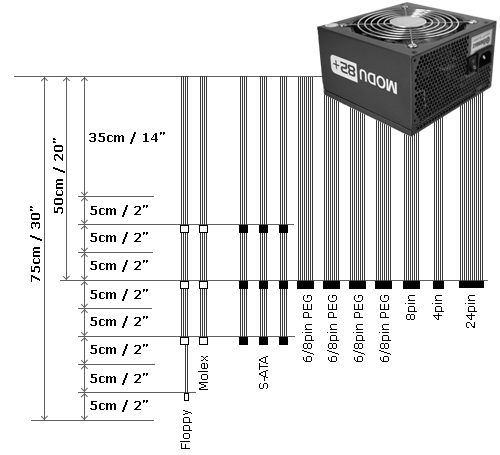

The installed fan is the same in all versions of this series. We have a double ball bearing fan that runs extremely silent. At 500 to 1000 RPM, this fan is not audible from three feet away; only when you put your ear right next to the fan can you will hear a very calm dragging noise.
Modu82+ Internals

Opening these units wasn't really difficult, but it is dangerous since the edges of the cover are extremely sharp. Looking at the inside, we see a similar design as we said before. We never really liked the internal appearance of Enermax power supplies, but at least they do their job. We haven't had an Enermax power supply fail either, so they're certainly not low quality. In fact, according to a recent survey Enermax is one of the most popular power supplies in the European enthusiasts market.

The filtering stage as usual is at the top of the power supply. All the necessary components are present, even though there's not a lot of space for them. The filtering stage leads into the primary part of the power supply on the right side. To our surprise, there are two main capacitors, which is something we don't see often in Enermax power supplies. They capacitors are rated at 85°C with 220µF and 400V.
Modu82+ Internals Continued

The PCB with the jacks for the cable management system shows a clear distribution of the different rails. One 12V rail connects directly to three pins of each graphics card connector. The other 12V rail distributes to the other three pins of the two graphics card connectors as well as the peripheral connectors.



The secondary side shows the cable distribution to the cable management PCB and the fixed cable harnesses. Here we see the three 12V rails, each with a different colored shrinking hose attached at the end. Each of the 12V cables outside of the PSU also has a color marking besides the basic yellow color. The rest of the capacitors are stuck behind the cables and manufactured by Nippon Chemi-Con. It looks a little bit messy in between these capacitors, which will definitely not help with airflow and therefore temperatures may be a bit higher. However, all these capacitors are rated at 105°C, which is actually quite normal. There are also lumps of glue applied in between the capacitors, which doesn't leave a good impression.


The fan is controlled with a PWM circuit, just as we see with modern CPU coolers for example. The fact that the fan is detachable is nice for those users that might want to change it. We have experienced enough PSU fan failures (or increased noise from failing bearings over time) that it makes sense to allow for an easy replacement of the PSU fan.
Enermax Pro82+

The name Pro for the Pro82+ series leaves the impression that it is for professionals. If these units are for the pros, then who is the intended user of the Modu82+ series? Anyway, the Pro82+ series differs from the Modu82+ only in its color and lack of cable management. As with the Modu82+ series, we have the claim of 88% efficiency, which is very high and not easy to reach.


We were lucky enough to get a lower wattage version of this series with 385W and the biggest version with 625W. The smaller version shows 20A on the 3.3V, 5V, and both 12V rails. The combined power of the 3.3V and 5V rail is 110W. Both 12V rails come with 30A combined which is 360W. The bigger brother has 24A on the smaller voltage rails and 25A on the three 12V rails.
Pro82+ Package and Appearance

The package is quite different from the Modu82+ series and comes in completely different dimensions. Maybe Enermax wanted to give the impression that these are two totally different series when users see these in a retail shop. The unit is enclosed in bubble wrap together with several accessories such as mounting screws, cable-ties, the power cord, and a manual.


The power supply comes with a black coating like previous Enermax power supply series. A big logo with the name of the series is printed on both sides of the unit instead of the label, which is now on the top. Now the logo can make it very clear what PSU you're using when you open up the case, even if you won't be able to easily see the specifications. As usual, the back is perforated so air can exhaust easily.
Pro82+ Cables and Connectors
Like the Modu82+, the cable harnesses are sleeved in a black mesh with a couple golden strings inside.

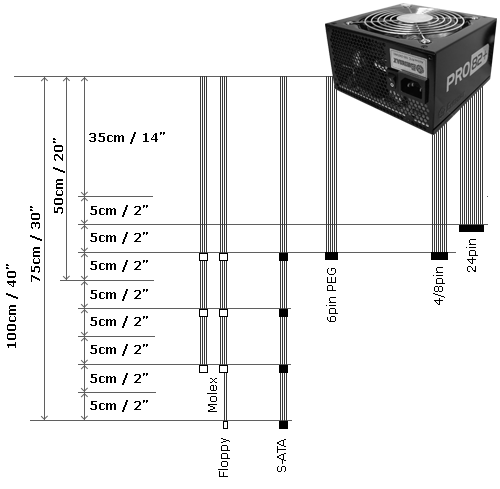
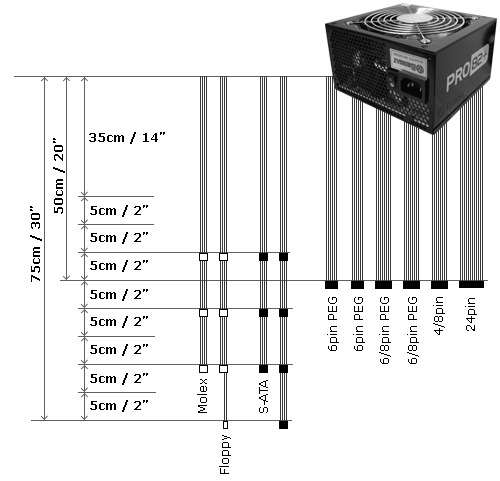
The 385W version is a little lacking in harness count, since these power supplies are not intended to run a large storage array. In total, you get a 6-pin PEG connector for a single graphics card, six Molex, and four SATA connectors. Given the target market, this power supply features all connectors one would desire. The length of the cables for both models is not very long and has a maximum of 75cm (or 30 inches).
The 625W version is better equipped due to its higher wattage and a different clientele. It has four PEG connectors, which is sufficient for a decent CrossFire/SLI setup. There are now two harnesses for each of the peripheral connectors. Seven SATA and six Molex connectors are included on this version.
Pro82+ Internals
In the following images, we will show the smaller 385W PSU, as these versions will be different from the higher wattage versions. Other than the lack of cable management, there's not much difference between the Pro82+ and Modu82+.

When we open up the casing, we are greeted by almost complete emptiness. Rated to deliver slightly less than 400W, there's little need for more complex layouts with many extra components, unlike the 625W models.

The filtering stage seems equally equipped, as we have seen before. All the necessary components are there, though it's a little more sparse than in larger PSUs.


The primary side features a single main capacitor instead of the two we saw in the bigger versions. That makes sense, as there is simply no need for more than this. With 220µF and 400V, the capacitor is not big but it's enough for this power supply. Enermax went with a Hitachi capacitor on this side. Hitachi can be found in most modern high-end power supplies, and they provide very good quality and performance. The choke is attached to the heatsinks and hangs from the side. The solder joints in general aren't that great with Enermax, but everything seems to work out fine.
Pro82+ Internals Continued

Things seem to be a little better arranged on the secondary side, unlike the Modu82+ 625W before. This is because there are fewer components needed for a lower rated power supply such as the 385W version. On the right side, a Silicon Touch microchip handles all the safety features such as OCP.


The capacitors on the secondary side are from Nippon Chemi-Con, as stated on the package.
DC Output Stability and Quality
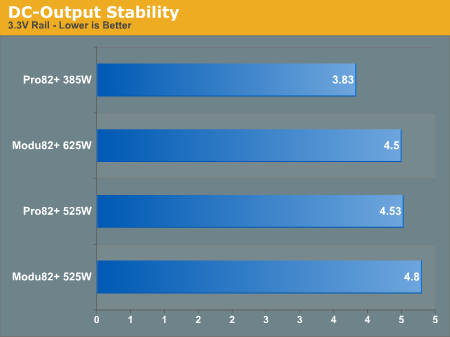
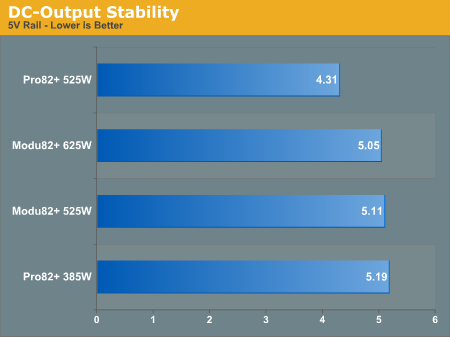
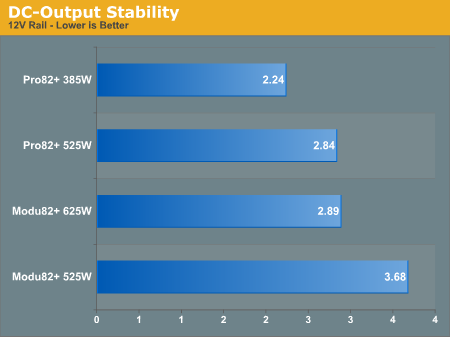
On the above graphics, we show the percentage the power supplies are able to regulate the voltage output. The test shows that even power supplies in the same series do not always perform the same. The most important rails are the 12V rails, and here the 385W version is clearly regulating well. The Pro82+ 525W and Modu82+ 625W are both under 3%, which is also a very good result.
Detailed Voltage Distribution
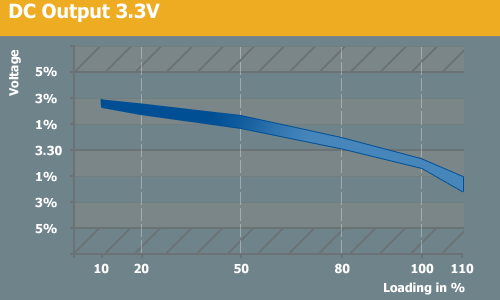
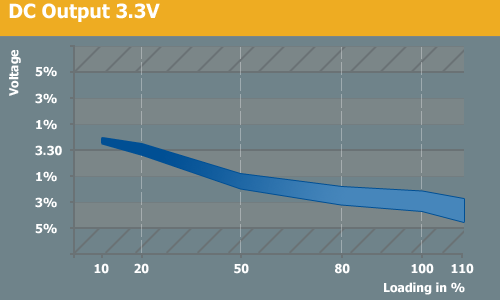
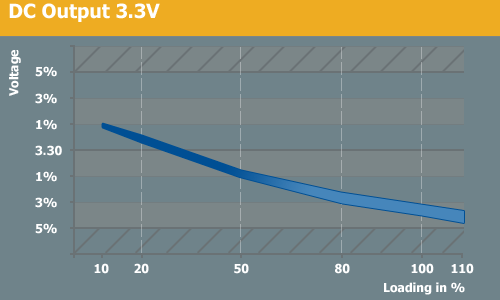
Both larger versions 525W and 625W models have slight problems with higher loads, since the voltage drops towards the lower end of specification. In contrast, the 385W starts quite high and thus doesn't drop too far under the specified ideal output of 3.3V.
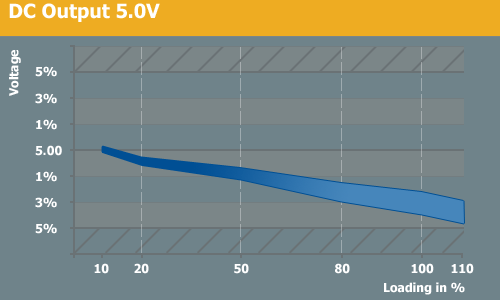
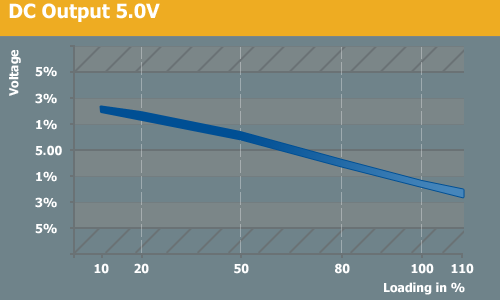
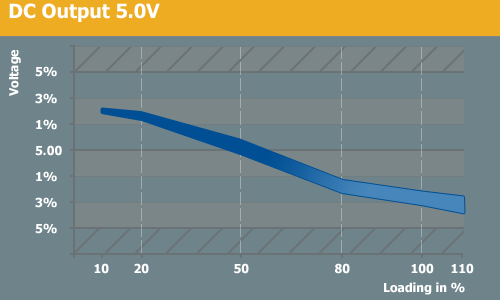
It looks odd when watching the regulation of the 385W. In fact, it doesn't differ too much from the others and regulates within 4-5%, but the 5V rail starts at about 5.00V and then drops very low as load increases. The 3.3V started much higher and therefore the drop doesn't matter too much. Regardless, all tested PSUs are well within specs so there's nothing to worry about.
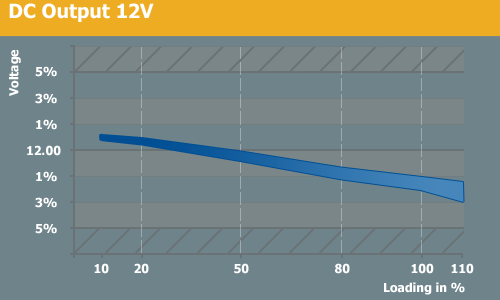
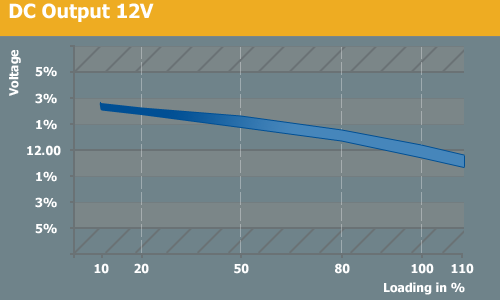
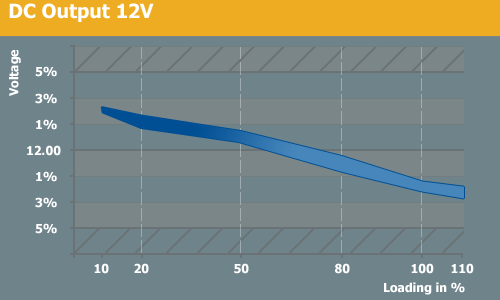
The 12V rails look good on all of the units. The best results come from the 525W power supply, since it does not drop much under the specified ideal 12.00V. The other units look decent as well and there is nothing to worry about. The Pro82+ and Modu82+ provide very good and stable DC regulation.
In case of ripple and noise, we were surprised to see very little distortion on the rails. The highest amount of ripple on the 12V rail was 16mV for example. The other rails were similar except the 5Vsb rail, which went a little high. That's pretty common, unfortunately.
Efficiency and Acoustics
One of the most important factors for an end-user in choosing a power supply is efficiency. Below we have three graphs that show the efficiency with 90, 120, and 230 VAC. The lower the input voltage is the lower the efficiency of the power supplies becomes; this is why the graphs on the last figure are much higher. We are calculating our loading chart according to Intel specifications of the latest ATX norm. However, we were asked to switch over to the 80Plus loading charts since more and more companies are using that now; rumors say that even Intel is using it already.
The difference between the specifications is that 80Plus is a more realistic calculation that loads the 12V rails much higher than the current Intel spec does. This results in higher efficiency ratings for starters. This is why our results don't quite match up with Enermax claims on their packaging; Enermax made that statement according to 80Plus tests.
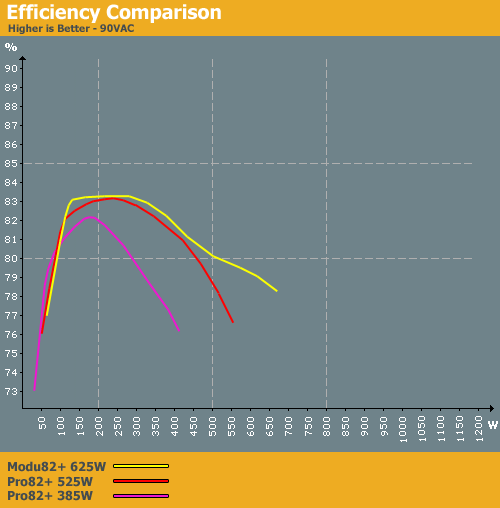
At the lowest input voltage, the 625W Modu82+ performs very well with a very long period of high efficiency. The 385W performs the worst with a short summit of just 82% and 190W of load.
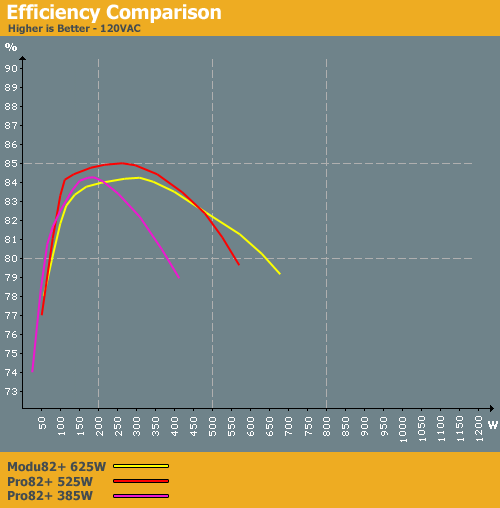
With 120VAC, the chart looks slightly different. Here we have the 525W version performing best and the power supply is able to come up with 84% at only 100W. It keeps this efficiency up to 400W and then slowly sinks. The small 385W version again performs worst and has only a short peak of 84% at 180W.
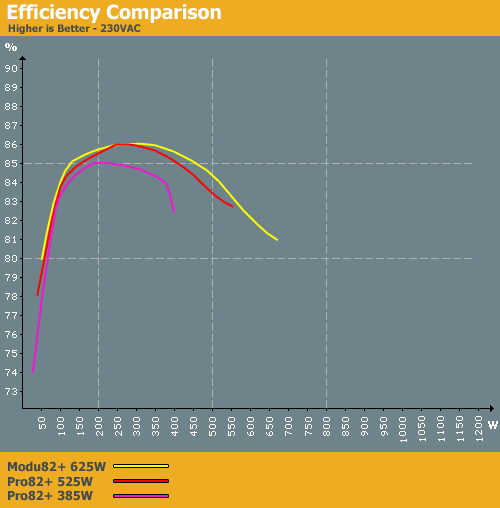
Finally, at 230VAC the graphs change again. As expected, the efficiency is much better. The 625W unit has a very nice and long lasting efficiency of over 85% from 100W of load. Even until full load of roughly 600W it keeps its efficiency high at a minimum of 82%. The 385W also performs well, but of course in a much smaller range. With only 50W of load, this power supply has 80% efficiency. It keeps efficiency above 82% even with 110% of load, which is a little more than 400W. These results clearly show the high performance of the tested units.
Acoustic Noise
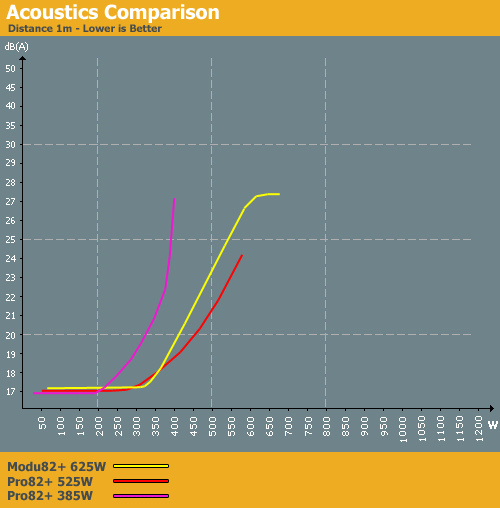
The fan control unit is the same in all the units, and it regulates the fans according to the load of the power supply. All of the units stay totally silent with only 17dB(A) and 500 RPM until 50% of their load. The fan then starts turning faster and reaches 1500 RPM with maximum load applied to each unit. Only the 525W model doesn't quite reach 1500 RPM, topping out at 1300 RPM instead and thus creating less noise with only 24dB(A) with 110% load!
In general, these power supplies are simply not audible during normal use. The fans run at slightly less than 500 RPM, which is very slow. You can only hear the fan when you get your ear within an inch or two of the fan. You will then hear a sliding noise. Even at full load, 27dB(A) isn't very loud and will qualify as near-silent for most users. If you run a high-end graphics card or two, the fans on the GPUs will definitely drown out the noise of the power supply at any load.
Conclusion and Prices
We are impressed by Enermax for coming up with these two series, even if they are quite similar. Enermax already showed promise with the previous Infiniti design, and the Pro82+ and Modu82+ set a new standard as Enermax tries to attack several markets at the same time. First, Seasonic now has some real competition in their quest to become the reincarnated PSU god of silence. The German market has the be quiet! power supplies, which at the moment are at least the second most sold brand for enthusiasts. Both brands are famous for their silent operation, and Enermax is definitely aiming for that market as well.
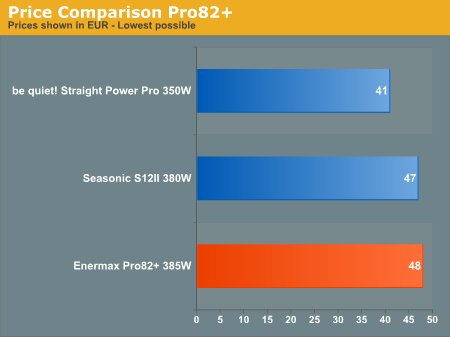
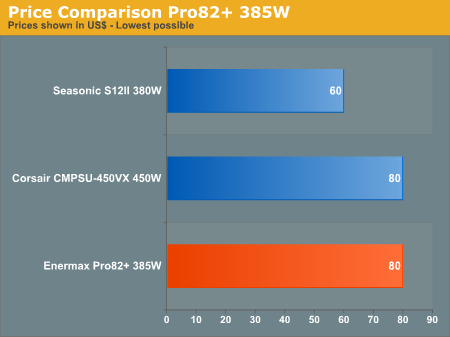
As we see at the price comparison, Enermax has a moderate price policy. Since these models are brand new, we expect the prices to fall somewhat in the near future. Enermax provides good technology and performance in their offerings, and they do it with better noise readings. The "quality budget" sector also gets a new option, as there are few good PSUs in the low wattage market, and we're not aware of any new models targeting this market from other vendors. The larger versions feature four 6/8-pin PEG connectors, which is not a common trait among their competitors.
Performance-wise, both of the new series showed very good results today. We have to say we like the Pro82+ a little better since it has much better pricing at the moment, but as stated this can change once the power supplies are available in greater volumes. The cable management of the Modu82+ is very good, and users will have no problems with it. The new 12-pin jack also buys Enermax some future expandability, since they can always adjust the harness and connector and leave the jack untouched. This is why Enermax has the right to put "future ready" on the package, though how meaningful that will be in the long run remains to be seen.
The efficiency ratings are very good, and especially the smallest version, the Pro82+ 385W, performed very well. All of the units reached a very good 86% efficiency maximum, and they also maintained a high efficiency level throughout the loading test. Voltage outputs were stable, and especially the important 12V rail performed within 2% to 3% of regulation.
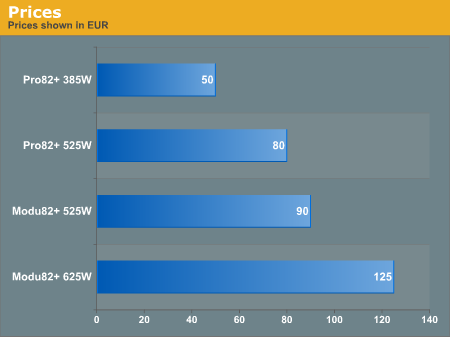
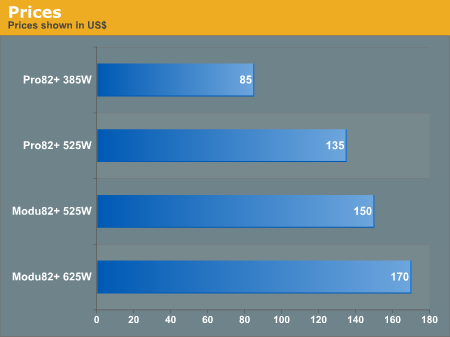
When it comes to prices, we have the first prices available now but Enermax is still working to increase supply. The prices will surely drop in the next couple of weeks when more units are available at all the major retailers. Right now, the lowest price in Europe for the smallest version is 48 EUR, which is a good start. The Modu82+ models are quite a bit higher, apparently because of the extra features and the desirability of modular cabling. This can be seen clearly with the 625W versions of the Pro82+ and Modu82+, where the Pro82+ costs 105 EUR and the Modu82+ costs 125 EUR. The cable management definitely shouldn't add 20 EUR to the price; whether prospective buyers agree with that or not will determine how much that gap closes.
 |
The Enermax Pro82+ and Modu82+ both perform extremely well in our tests, and as such we are awarding both series our Gold Editors' Choice Award. Users can't go wrong with these power supplies, and silence (without going fanless) has been redefined today. Enermax truly has the quietest air-cooled power supplies in the market right now, and the prices (at least for the smaller versions at the moment) make these units relatively affordable and very attractive.











